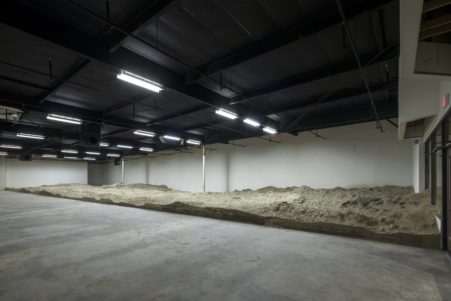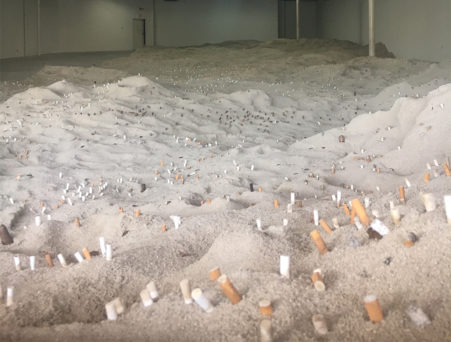Palm Springs may be the furthest eastern reach of Los Angeles’ urban/suburban schizophrenia and whiny babblespeak, but the Palm Springs Tourism Board has done its best to overcome such a provincial status by adopting the slogan, “Like No Place Else.” That can be said with certainty, for although Palm Springs is located in the Sonoran Desert, it obliquely promotes itself as a beach town without an ocean and the main boulevards are lined with Tropical themed bars and Tiki motels. Such wishful thinking helps the city maintain its distance from plebian reality, but that’s apparently not enough: some spaced out city fathers decided to also throw Art into the mix for bad measure. And so came about Desert X, a city-wide series of art installations that ostensibly brings high art culture to this Post-Surf fantasia. One particular piece, Donation Box by Gabriel Kuri, stands out as a prime example of art that appeals to the locals’ fondness for reality avoidance. Unfortunately, this piece also embodies pretty much everything that gives the art world the bad reputation it holds for most secular, that is, non-art damaged viewers.

Gabriel Kuri, Donation Box, Installation view. Photo courtesy Desert X
First off, due to the repulsive nature of its components, viewing Donation Box is a particularly unenjoyable experience. Consisting of “a vast expanse of sand peppered with extinguished cigarette butts,” it can only be seen through the plate glass windows of a vacant store in a bleak commercial mall bordering Palm Springs’ city limits. Beyond the parking lot lies only sand and scrub, which is, according to the Regen Projects press release, the apparent inspiration for Donation Box. This “rather surreal scaled-down and boxed-in version of what otherwise lies right outside the shop” brings no enlightenment or joy; it’s like looking at a dead animal in its cage at the zoo. Plus, the inert uselessness of presenting what is already there makes this a needlessly vapid “now-you-see-it, now-you-see-it-again” experience .

Gabriel Kuri, Donation Box, Detail.
But the most appalling aspect of this lame redundancy lies in the egregious concept that calling something “art” and putting it in a gallery somehow makes it more interesting and valuable than the same damn thing on “the outside.” What exactly is it that makes reality so unappealing that people will drive miles to examine something in an art environment that they studiously avoided looking at on the way there? To figure this one out, I asked a woman who joined me at the window. Waving her Desert X installation map at me, she opined that “each cigarette butt represents a thought,” apparently indicating to her that the homeless guy putting out his cigarette in the sand behind the mall was a strictly reactionary organism. Really? I told her I had to think about that for a while, which apparently suited her just fine as she was back in her car in less than a minute and driving past all those cigarette butts in the desert sands to go check out the next piece of art.


